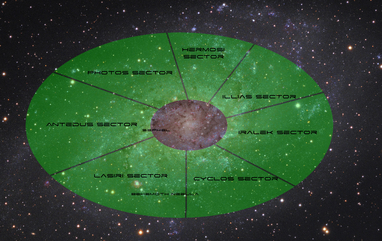| Triangulum Galaxy | |
|---|---|
 The Triangulum Galaxy | |
|
Type |
SA(s)cd |
|
Age |
13.2 billion years |
|
Diameter |
50,000 light years |
|
Galactic year length |
200 million years |
|
Number of stars |
40 billion |
The Triangulum Galaxy is the third-largest member of the Local Group, after the Milky Way and Andromeda Galaxy. It is a low-luminosity, high-metallicity non-barred spiral galaxy.
Structure[]
Triangulum has a diameter of about 50,000 light years, and is home to around forty billion stars. It has an estimated mass of ten billion solar masses, though it has fifty billion solar masses if dark matter is included.
It is a non-barred spiral with two major inner arms and a large number of spurs connecting the arms. Star formation is currently very rapid, possibly due to its interactions with the Andromeda Galaxy. Whether it could be classed as a satellite of Andromeda is uncertain. A number of diffuse 'ghost arms' are also present. It has a well-defined leading edge of denser gas and closely-packed stars.
A large proportion of stars in Triangulum are very hot and young. The northern main arm contains several very large and bright HII regions and has recently had an outburst of stellar formation, resulting in a greater proportion of hot, young stars. The southern arm contains more stellar remnants.
There are many globular clusters in Triangulum. Many of these are several billion years younger than those of the Milky Way, and new globular clusters are currently forming.
Triangulum's core is very hostile to life due to the presence of very strong X-ray sources. The central black hole has a mass of less than 3,000 solar masses, far smaller than that of the other large galaxies in the Local Group. The galaxy is quite metal-rich and quantities of heavy elements suitable for forming habitable systems exist far from the galactic centre. Triangulum's galactic habitable zone covers about 20% of its stars.
List of Notable Systems[]
List of Triangulum's notable systems by sector.

Triangulum's sectors
Antedus Sector[]
- Dahsava
- Skarspell
- Assafi
- Krilyi
- White Orb
Cyclos Sector[]
- Eurna
- Nasalla
Hermosi Sector[]
Illias Sector[]
- Salmandra
- Tellepha
- XL01F
- Ulf
- Baptos
- Themea
- Zessen
Iralek Sector[]
Lasiri Sector[]
Photos Sector[]
- Iraia
- Mirn
- Quatzu
- Beuld
- Hekati
Notable Factions[]
Notable factions of the Triangulum Galaxy.
- Amber Nexus
- Democratic Systems Republic
- The Everlasting Celestial Empire
- Imperium of Flame
- Iralek Alliance
- Nemesis Legion
- New Heaven
- Terminal Interface Fifteen
- Zjeveni Void
History[]
Triangulum formed over 13 billion years ago.
Several billion years ago, it interacted with the Andromeda Galaxy, and several streams of gas and stars still connect the two. It has on occasion been classified as a satellite of Andromeda.
The first evidence of civilisation in Triangulum dates back to 156 million years ago in the form of the Myriagon, located in the Triangulum Core Zone. Traces of depleted uranium of a similar age have also been discovered in the Cyclos Sector, and a derelict bearing several trillion-tonne micro black holes was located orbiting a neutron star but is currently unapproachable due to its proximity to the object. As only a small percentage of systems in Triangulum have been explored, it is possible that the remnants of many ancient societies remain undiscovered.
After this, there seems to have been a ninety-million-year pause before any further civilisations emerged. The ruins of a spacefaring civilisation were discovered on the planet Rehea which lost its atmosphere following a nearby supernova. The nearby colonies were also destroyed during the event. The Henshu system bears the evidence of a relativistic war forty million years before the present time.
No ruins have been discovered that are from civilisations between two million and ten thousand years old.
At the current time, Triangulum hosts several dozen spacefaring factions at varying stages in development and technological progress, including the Imperium of Flame, Shekeshta Hegemony and Shull Royal Systems. Many conflicts are ongoing and the galaxy is more active than it has been for over one hundred and fifty million years. The number of civilisations arising at very similar times to each other is likely due to the timing of ancient stellar and planetary formation.
Triangulum will return for another pass with Andromeda in around 2.5 billion years. It may be torn apart and fuel further star formation in Andromeda or may escape again and participate in the eventual Milky Way/Andromeda merger.
Satellites[]
Triangulum has one possible satellite, the Pisces Dwarf.
Triangulum Galaxy (Portal) All articles | |
|---|---|
| Antedus Sector |
|
| Cyclos Sector |
|
| Hermosi Sector |
|
| Illias Sector |
|
| Iralek Sector |
|
| Lasiri Sector |
|
| Photos Sector |
|
| Major Factions |
|
| Major Locations |
|